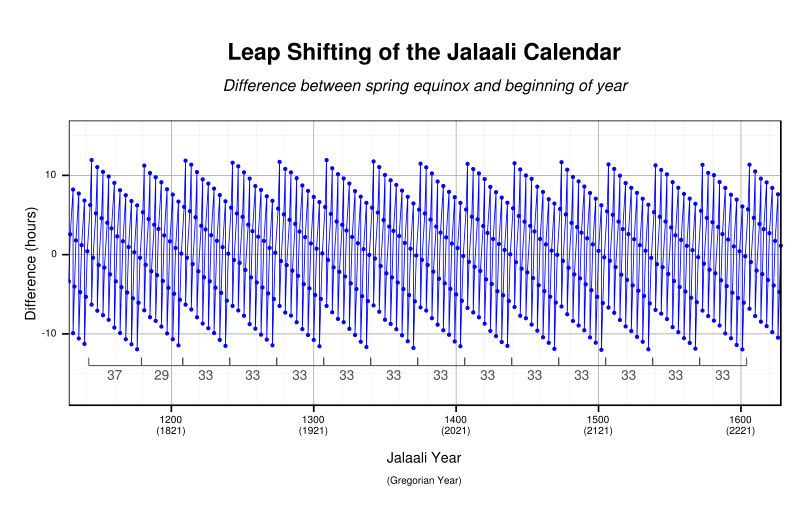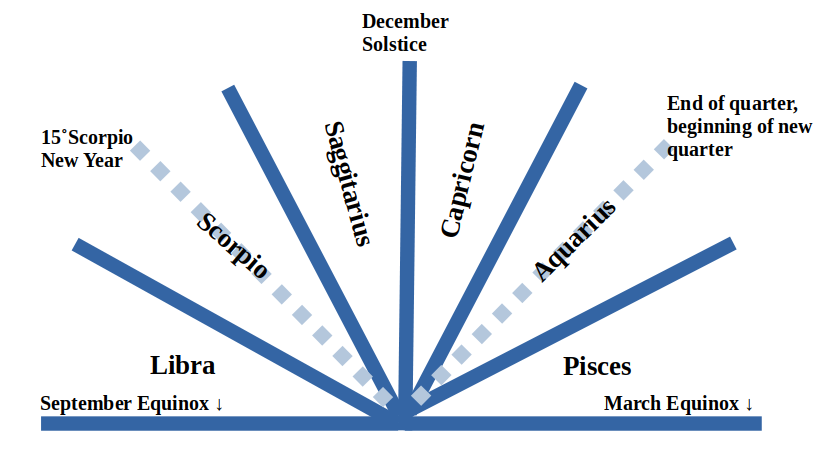| (18.16.12) 11.722 Northlight 85 (9.03 |

Length of this time unit:
A year in the Earth Epic Calendar is the length of time between the midnight (UTC) closest to the moment the Sun enters 15˚ Scorpio and the midnight (UTC) closest to the next moment the Sun enters 15˚ Scorpio. This will be either 365 or 366 days.
Rationale
The length of the year should be the same as it is now with almost all calendars, because the length of the year on Earth has been remarkably constant, going almost all the way back to our planet’s beginning.
But why set the beginning of the year astrologically? What the heck does it mean when the sun enters 15˚ Scorpio? Each of these two questions will be answered in the next two subsequent sections.
Why set the beginning of the year astrologically?
If you were to ask the average Westerner how long a year is, they’d say 365 days except for Leap Year when it’s 366 days. Neither figure is accurate. The actual length of the year is in between–what changes is the time of day upon which it falls. The mean tropical year is 365.2422 days.
The Gregorian calendar, despite its almost universal use, is not the most accurate widely used calendar in the world. That honor actually belongs to the Solar Hijri calendar which is the official calendar in Iran and until recently* was the official calendar of Afghanistan. (White supremacists will cringe at the thought. Good.) Both calendars have leap years with leap days, but the Gregorian leap years are mathematically fixed while the Solar Hijri leap years are astronomically fixed.
The Solar Hijri calendar simply measures the year as being between the midnight closest to the Northward (Spring) Equinox and the midnight closest to the next Northward Equinox. Most of the time it means that leap years are four years apart, but once in a while they are five years apart. You can see from the charts below that the Gregorian calendar’s formula allows the beginning of the tropical year to vary by as much as two days, while the Solar Hijri calendar limits that variability to just ten hours or so.


So the New Year’s Day in the Earth Epic Calendar does the same things, except that the first day of the New Year is established as the midnight closest to the day and time the sun enters 15˚ Scorpio, which is currently November 7 or 8.
Why set the beginning of the year at 15˚ Scorpio?
Calculating the Earth’s position relative to the sun is a more accurate way to measure a year than counting days because of the elliptical nature of Earth’s orbit.
A little bit of basic astrology structure will be helpful here. Astrologers divide the planetary plane–the relatively flat disc upon which planets Mercury through Neptune rest–into twelve sections. The sections correspond to the Western astrological signs Aries through Pisces. When Western astrology was invented, the Greeks knew that the Earth was round but thought that the Sun and planets orbited the Earth. So most astrologers will still talk about the Sun entering a certain sign (a pie section of the Solar System) even they know it’s the Earth’s position related to the Sun.
The Solar Hijri calendar actually bases its months on the signs of the Zodiac. But this isn’t a Muslim endorsement of using astrology to predict the future. It is simply a way of plotting the planets in the Solar System and modeling the two dimensional planetary plane. This aspect of astrology has evolved through several millennia from the Babylonians to the ancient Greeks to Christian and Muslim astronomers who added their own knowledge to the field. NASA distances itself from astrology. While astrology has debatable divination capabilities, the way that astrologers map the Solar System is well established, ancient, and isn’t likely to go away.
The orbit around the sun is divided into 360 degrees, with each astrological sign occupying 30 degrees. The Solar Hijri starts its new Year at the midnight closest to the moment where the Sun enters Aries, or more precisely, when the Sun reaches 0˚ Aries.
So the sun at the September Equinox is at 0˚ Libra and at the December Solstice it is at 0˚ Capricorn.
But why 15˚ Scorpio? A look at the diagram below will establish why. Rather than having the December Solstice start the new year, it falls right in the middle of the first quarter of the year. Thus the days surrounding it have, for the most part, the longest nights of the year in the Northern Hemisphere and the longest days of the year in the Southern Hemisphere. It is at the time of the year that the sun’s most direct sunlight is at its southernmost point.
Furthermore, if I were to start the year–Southlight 0–at the December Solstice (0˚ Capricorn), the Spring Equinox would occur before the end of Southlight and the most direct sunlight would already be north of the Equator.

Saying what year it is
We know from the Epoch page that the first year of this Epoch began in 9701 BCE (technically, early November 9702 BCE). So now we are in the decade of the 11.720s.
The year is expressed really in two parts–the millennium and the years within the millennium. So 11.724 is Millennium 11, Year 724. The Earth Epic Calendar express the year this way because just as people might want to refer to 2024 as ’24, people might want to refer to 11.724 as 724. Why three digits? That way, if we want to reference the year 11.694 (1994) in the last decade of the previous century, we can just say 694 and there would be no confusion as to what century we’re talking about. The century essentially replaces the apostrophe.
It’s noticeable that after the turn of the millennium in the Gregorian calendar, people were more often in the habit of writing the year with four numbers than before–most likely because of the novelty of starting the year with a “2” instead of a “1.” Now that we are a couple of decades into the 21st century CE, it appears the novelty has worn off some and more people are writing the year with two numbers again in informal discussion. As such, I suspect that people might find it novel to write the Earth Epic year with five digits to start with, but it’s possible that after a while, people might find it easier to just write it with three digits.
* On March 25, 2022, the Taliban government of Afghanistan announced that they would be changing the official calendar for government correspondence from the Solar Hijri calendar to the Hijri lunar calendar. The change would be effective as of July 30, 2022, which is the first day of Muharram, the first month of AH 1444 in the Islamic lunar calendar.
—> continue on the Calendar Tour to the Quarters
<— go back to the Calendar Time Scales
return to the Basic Structure of the Calendar page